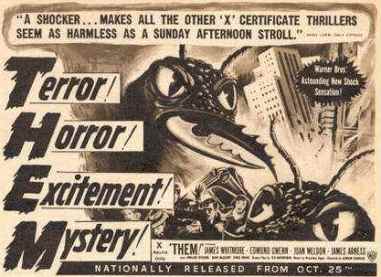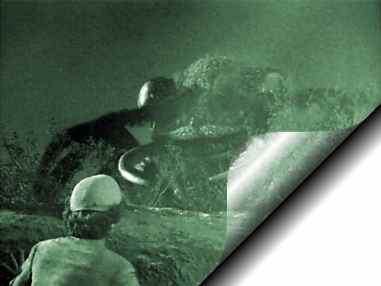
August 16, 2007

Opening today, August 16, in Australia, is a debut film, Black Sheep, from writer-director Jonathan King. A movie about killer mutant sheep, in which genetic engineering is the evil underpinning of the film, doesn’t sound too cryptozoological. But Black Sheep and its little mutant lamb that foreshadows thousands turning into bloodthirsty predators is reminiscent of scores of other films about “monsters.”
Australian entertainment journalist Frank Crook has used the opening of Black Sheep to contribute a great overview of the genre. Here’s part of his wonderful article:

The new film follows the tradition of scores of movies about animals and insects that turn on people. Many early efforts were locked in their B-film origins: Attack Of The Crab Monsters, Attack Of The Giant Leeches, Killer Bees, Empire Of The Ants and The Swarm.
The modern cinema has produced a handful of classics, such as Moby Dick, Alfred Hitchcock’s The Birds and Jaws, the film that sealed Steven Spielberg’s reputation as one of Hollywood’s brightest new directors.
Among them are lesser efforts such as Anaconda, in which a giant snake eats most of the cast; Lake Placid, inhabited by a giant alligator; and Cujo, the tale of a rabid Saint Bernard dog.
The grandfather of all animal-attack films was King Kong, produced in 1933 and remade in 1976 and 2005. King Kong was taken from an original story by Edgar Wallace and written for the screen by Merian C. Cooper.
The black-and-white original was known for its pioneering special effects, using stop-motion models and animatronics. The final scene, with the giant ape holding the heroine in the palm of its hand while clinging to the newly-erected Empire State Building, remains one of the screen’s great images.
In April 1961, Alfred Hitchcock read a story in the Santa Cruz Sentinel in California about birds exhibiting strange and aggressive behaviour. It led him to a story by Daphne du Maurier about birds massing together to attack a seaside village. Hitchcock shot The Birds in 1963, starring Tippi Hedren and Australian Rod Taylor.
Working with birds was no easy matter. Hedren was originally told only mechanical birds would be used. But live birds were hurled at her for a week by studio prop men. One nearly gouged one of her eyes and she collapsed, unable to continue filming for a week.
In the scene near the end of the film when she is ravaged by birds, the attacking birds were attached to her clothes by long nylon threads. It was a long and terrifying shoot but worth it in the end. The Birds was one of Hitchcock’s biggest hits.
Jaws, made in 1975, started the wave of killer-animal films of the late 1970s. It was credited as one of the first films to use traditional B-grade elements — horror and gore — in a big-budget film.
The film was inspired by both Peter Benchley’s novel and a real-life spate of shark attacks on the Jersey Shore, which cost four lives in 1916.
Three mechanical sharks — all dubbed Bruce after director Steven Spielberg’s lawyer — were used in the filming, designed by production designer Joe Alves and special effects artist Bob Mattey.
Jaws, starring Roy Scheider, Richard Dreyfuss and Robert Shaw, was shot at Martha’s Vineyard in Massachusetts.
Each of the Bruces was prone to malfunction, which actually helped the film, as Spielberg was forced to shoot scenes with the presence of the great white shark only hinted at. This helped build suspense, along with a throbbing musical score by John Williams.
Jaws turned out to be the father of the summer blockbuster, leading to three sequels, Jaws 2 (1978), Jaws 3-D (1983) and Jaws: The Revenge (1987). Spielberg had no connection with the sequels. The film Piranha (1978) directed by Joe Dante, was a send-up of the genre.
Films featuring homicidal wildlife had their origins in the science-fiction films rolled out in Hollywood in the 1950s, when the Cold War was a fact of life and the threat of communism ever present. Them! made in 1954 was an early example.
Them!, featuring a battle with a nest of giant ants, was one of the first nuclear monster films. The ants had grown to their gigantic size because of US nuclear testing in the nearby desert.

Japan had discovered the nuclear thriller about the same time. Godzilla, first seen on the screen in 1954, was spun off into a series of 28 films starring the giant dinosaur, transformed because of fall-out from hydrogen-bomb tests. Godzilla was released in the US in 1956, with new footage for the American market, featuring Raymond Burr.
Attack Of The Giant Leeches (1959) also played on symbolism. The story concerned a colony of human-size, intelligent leeches in the Florida Everglades, which preyed on their victims from their underground nest. The leeches were seen as a deadly threat to the human race as anti-communist hysteria peaked. But it didn’t help when the giant leeches were obviously actors dressed in rubber suits.
Moby Dick, filmed in 1956 and based on the classic novel by Herman Melville, pitted a demented sea captain against a great white whale. It could have been a forerunner to Jaws, filmed nearly 20 years later.
Many of the villains in killer animal films were tragic figures misunderstood by humans. Others were victims of experiments gone horribly wrong. But most were just nasty and hungry.
Bug featured killer cockroaches; Squirm was about flesh-eating earthworms; The Swarm starred killer bees. Crabs grew to an enormous size because of nuclear radiation in Roger Corman’s Attack Of The Crab Monsters (1957).
Genetically-mutated giant rabbits terrorised a farmer played by Rory Calhoun in Night Of The Lepus. The film, all but forgotten today, has the line: “Attention! Attention! Ladies and gentlemen, attention! There is a herd of killer rabbits headed this way and we desperately need your help.”
Australia got into the act in 1983 with Razorback, the saga of a giant pig terrorising the Outback.
Directed by Russell Mulcahy, it starred the American actor Gregory Harrison with a solid Australian supporting cast, including Bill Kerr, Chris Haywood, Judy Morris and Arkie Whitely.
A full-sized animatronic model razorback cost the producers $250,000 and was seen on the screen for only a matter of seconds.

Practically every creature used in animal killer films appeals to our most basic instincts. Fear of spiders is exposed in Arachnophobia; rats brought about similar emotions in Willard, the 1971 story of a boy who sets his pet rats loose on his tormenters.
The film spawned a sequel and a recent remake. There was also The Deadly Mantis, while a young Joan Collins was tormented by another nest of giant ants in Empire Of The Ants.
Man’s best friend turned killer in Cujo and The Hound Of The Baskervilles, the Sherlock Holmes adventure filmed in 1939 and again in 1959.
So Black Sheep is in good company. A good scare never did any harm at the box office.“Beastly old ways to scare your socks off” by Frank Crook, August 13, 2007, Australian News.

About Loren Coleman
Loren Coleman is one of the world’s leading cryptozoologists, some say “the” leading living cryptozoologist. Certainly, he is acknowledged as the current living American researcher and writer who has most popularized cryptozoology in the late 20th and early 21st centuries.
Starting his fieldwork and investigations in 1960, after traveling and trekking extensively in pursuit of cryptozoological mysteries, Coleman began writing to share his experiences in 1969. An honorary member of Ivan T. Sanderson’s Society for the Investigation of the Unexplained in the 1970s, Coleman has been bestowed with similar honorary memberships of the North Idaho College Cryptozoology Club in 1983, and in subsequent years, that of the British Columbia Scientific Cryptozoology Club, CryptoSafari International, and other international organizations. He was also a Life Member and Benefactor of the International Society of Cryptozoology (now-defunct).
Loren Coleman’s daily blog, as a member of the Cryptomundo Team, served as an ongoing avenue of communication for the ever-growing body of cryptozoo news from 2005 through 2013. He returned as an infrequent contributor beginning Halloween week of 2015.
Coleman is the founder in 2003, and current director of the International Cryptozoology Museum in Portland, Maine.
Filed under Breaking News, CryptoZoo News, Cryptozoologists, Cryptozoology, Movie Monsters, Photos, Pop Culture